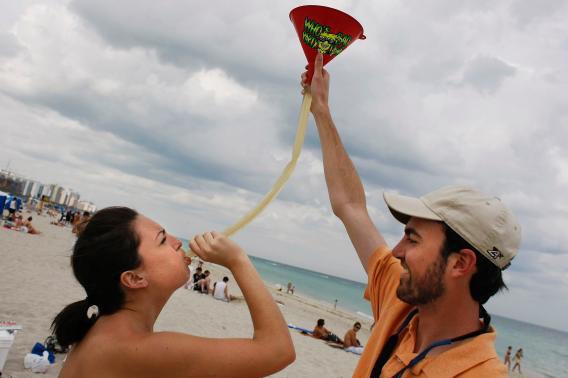One salient fact that often seems to go missing from the higher education debate in wonky circles is that college is, typically, fun. At least that’s the case for the “traditional” college students and the institutions that serve them. Schools clearly invest a fair amount in providing student amenities that are designed to enhance the fun factor—sports teams, student centers, etc.—and new research from Brian Jacob, Brian McCall, and Kevin Strange indicates that these investments tend to pay off:
This paper investigates whether demand-side market pressure explains colleges’ decisions to provide consumption amenities to their students. We estimate a discrete choice model of college demand using micro data from the high school classes of 1992 and 2004, matched to extensive information on all four-year colleges in the U.S. We find that most students do appear to value college consumption amenities, including spending on student activities, sports, and dormitories. While this taste for amenities is broad-based, the taste for academic quality is confined to high-achieving students. The heterogeneity in student preferences implies that colleges face very different incentives depending on their current student body and the students who the institution hopes to attract. We estimate that the elasticities implied by our demand model can account for 16 percent of the total variation across colleges in the ratio of amenity to academic spending, and including them on top of key observable characteristics (sector, state, size, selectivity) increases the explained variation by twenty percent.
The paper itself is gated so you may not be able to read it, but peering beyond the abstract, the key fact is that the ratio of amenity-to-instructional spending is quite varied “from .26 at the 10th percentile to .80 at the 90th percentile” which lets us study this issue. A telling broad generalization is that private institutions not only spend more per student than public ones, but have a higher ratio of amenity spending. So you see from the mathematical analysis that students seem to select for high-amenity schools, and also that schools operating in a more market-oriented framework spend more on amenities.
This suggests that one way to reduce college “costs” (i.e. spending) would be to make the system more drab and utilitarian. That would start with withdrawal of subsidies from private institutions and reductions in amenity spending at public ones. The cash flows freed up by de-subsidization of private institutions and reduced amenity spending at public ones would allow the new drab and utilitarian public universities to charge much lower tuition and let students graduate with less debt. Affluent parents might still choose to spend their money on sending their children to fancy schools for a high-class edutainment experience (affluent parents have to spend their money on something) but wise people would at least try to socially stigmatize the practice of making “charitable” donations to such institutions.
On the other hand, I do think it’s a bit misleading to characterize money spent on enjoyable consumption experiences as a “cost” per se. Drabber, more utilitarian colleges would be cheaper than today’s schools, and doing coursework at MOOCs would be even cheaper. But to a large extent the “savings” here simply amount to purchasing an inferior product. It probably shouldn’t surprise us that an industry whose customer base is teenagers features decision-making that isn’t necessarily about maximizing long-term value.
